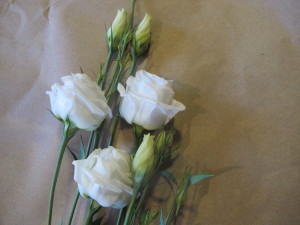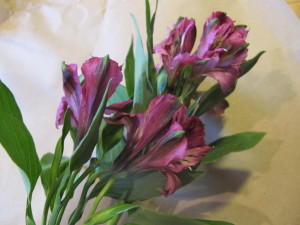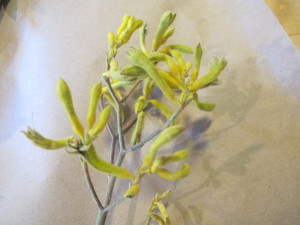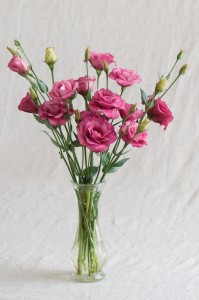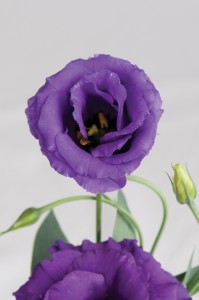Buying Cut Flowers
Technically, winter is here – despite the lack of snow. The sun is often lurking behind gray clouds, and on a good day we get just 9 hours of light. I miss the colors of summer. I still try to keep fresh cut flowers on the table – even if they’re not flowers from my garden.
Cut flowers are among modern America’s true bargains. For the price of a bottle of wine – or even a few of cups of fancy coffee – you can buy flowers that will grace your table for up to three weeks. But there are some things you should know about getting good table-life for your investment.
First, you need to buy fresh flowers that have been carefully tended – and you can’t beat a florist for that. Yes, grocery stores sell bouquets, but many grocery stores sell bouquets in the fruit and vegetable department. Apples and some other fruits give off ethylene gas, which promotes ripening – or in the case of flowers, getting old and unattractive.
Cut flowers need to take up water to stay fresh and healthy. Stems tend to scab over after a day or two, which means they cannot take up replacement water, or not much, so they suffer. A floral shop has trained personnel who trim each stem in the store every other day, taking off three quarters of an inch each time. And someone who regularly changes the water to keep to keep it fresh. Chain grocery stores probably count on you buying their flowers before the flowers need to be trimmed or their water changed.
When you bring your flowers home, get them right in water. And follow the 3-second rule: never take longer than 3 seconds to get your flowers in the vase after trimming the stems. Most florists give you packs of powder to put in the water, and the stuff works to keep flowers fresh longer. It inhibits bacteria from growing, which is good. Bacteria will impede water take-up.
If you want maximum life out of you flowers, NEVER let leaves enter the water. Leaves will rot, promoting growth of bacteria. And keep your arrangement cool if you can. Putting it near a radiator or woodstove will shorten its life. If you have invested in roses or tulips, you may wish to move the vase to the entryway or mudroom at bedtime to keep the flowers extra cool during the night – or put them in the fridge.
Some flowers are better picks than others if you’re on a budget and can’t afford to buy new flowers every week. Here are my recommendations for good cut flowers:
- Lisianthus: These look like silk flowers to me: perfect white, pink or lavender-colored bell-shaped flowers on long stems. Tough to grow in the garden, they are perfect in a vase – I’ve kept them for up to 3 weeks.
- Miniature carnations: Each stem has 2 to 4 blossoms. They come in a variety of colors. Mix dark red “minis” with red roses to make a bouquet of roses look fuller. And even after the roses go to
Valhalla, the carnations will still be good!
- Chrysanthemums: These come in a variety of sizes and colors, from the huge spider mums to little guys. I love the scent of the flowers –it’s not overpowering, but it’s there if you sniff them.
- Statice. I grow these for use as dry flowers, which tells you that they really do last forever – even out of water. They come in blue, purple, pink and white.
- Spray roses: Instead of a single blossom per stem, these have 2-5 blossoms, giving you more bang for your buck. Will last about a week with proper care
- Alstromeria: Each long stem has clusters of 2-inch lily-like blossoms in pinks and reds, with yellow throats. Very long-lived. Great value.
- Kangaroo paws: These Australian natives are fuzzy and cute. They come in pinks, reds and browns, and last very well. Not every florist will have them, but ask.
Looking for a fun project with your kids? It’s easy to change the colors of chrysanthemums. Leave them out of water for 12 hours, then cut off 2-3 inches and put them in water with food coloring. Obviously, you should start with white chrysanthemums. The colors you get may not be exactly the color you see on the food coloring, but it can be quite dramatic.
Everyone loves to receive the gift of cut flowers, even guys. So treat your loved one – or yourself- to fresh flowers this winter. They’re cheerful, and can make winter less oppressive.
Henry is the author of 4 gardening books, including a new, revised second edition of The New Hampshire Gardener’s Companion: An Insider’s Guide to Gardening in the Granite State. His website is www.Gardening-guy.com.
Starting Lisanthus And Other Flowers
Here it is early February, and many of us are itching to start some seedlings. Well don’t. Or at least don’t start your tomatoes – they only require 6 to 8 weeks and would be ready to go in the soil by April if you started them now. That’s way too early. But if you really want to get your fingers dirty and are willing to baby along plants for 4 months, there are things you can start.
Many years ago I commented to a professional grower that I loved lisianthus, a flower that is often sold by florists and occasionally sold by nurseries selling starts of annual flowers. In addition to looking gorgeous in an arrangement, it lasts forever in a vase. I’ve had them look good for 3 weeks or more. But she told me they were fussy. Difficult to get started. She told me I wouldn’t be able to start them myself, but should just buy seedlings (from her, presumably). That sounded like a challenge to me, so I decided to start some.
I did a little research and discovered that there are at least three sizes, or heights of lisianthus. I bought a packet of seeds of each. And they come in 3 colors: white, pink and purple/lavender. I learned that germination is slow: it takes 10 – 18 days at a constant temperature of 72 degrees. Like any seedling, they require good light, not just the sun of a south-facing window. I set up a light stand with fluorescent lights and set the thermostat in the bathroom where they were at 72 degrees. These babies were gonna be happy!
My lisianthus germinated in 18 days. Oh boy! I had a hundred or more seedlings! I adjusted the lights so they were just 6-8 inches above their tiny leaves. Every day I checked them, watered a little if need be, made encouraging murmurs. But nothing much happened. Those tiny green leaves just sat there, glaring at me. They refused to grow. One week, nothing. Two weeks, no change. And on and on. After several weeks they were the size of week-old radish leaves.
Eventually they started to grow, and when they went outside in full sun and got into the soil they took off like foxes in front of
hounds. They grew and bloomed in prodigious quantities. When frost came I dug up big clumps of them and brought them into the house as I couldn’t bear to see them succumb to the cold. In the house they finished up their life cycle after Halloween, if memory serves me well.
But most flowers are easier to start than lisianthus. The advantage to starting by seed is simple: a $4 package of seeds will provide dozens, even hundreds of plants. If you want to overwhelm guests at an August event with bushels of blossoms, you can. And many flowers you can start later, right in the ground. Some flowers that are relatively easy to start outdoors by seed include: bachelor buttons, calendula, California poppies, cosmos, marigolds, morning glories, nasturtiums, scarlet runner beans, sunflowers and zinnias.
On the other hand, starting flowers indoors means getting blossoms earlier. Most seed catalogs are primarily interested in selling you the seeds, so they tell you all about a flower’s wonderful characteristics or history – but not necessarily much about germination time, or how many weeks from seed to flower. One exception to that is Johnny’s Select Seeds (www.johnnyseeds.com or 877-564-6697). They sell to commercial growers and home gardeners and really tell you everything you need to know.
If you are looking for truly rare and wonderful seeds to start, you might want to check out a British company, Chiltern Seeds (www.chilternseeds.co.uk) . The late Tasha Tudor introduced me to their catalog years ago when I visited her at her home in southern Vermont. Chiltern Seeds is the exact opposite of Johnny’s Seeds: they provide no growing information at all, not even hardiness zones for perennials. Of course most of the United Kingdom has a mild climate so cold hardiness is not something they focus on.
What I like about the Chiltern catalog is that it has species of perennial flowers that I can’t find in even a most extensive nursery collection. Now it may be that I do not find Dicentra scandens for sale in New Hampshire or Vermont because it is a perennial that will not grow here. It’s a relative of our bleeding hearts but is a yellow (or pink) climber that it comes from the Himalayas – so it just might. My copy of the plant encyclopedia Botanica lists it as hardy to Zone 4 (minus 30) but I went on line and most people selling seed say it is only hardy to Zone 6 (minus 10 degrees). Either way, germination can take months, even a year, so I shall not buy seeds for it.
My Johnny’s Seeds catalog tells me to plant lisianthus 12-13 weeks before lost frost, so I still have time to order seeds. They have a tall one that is supposed to be dark red that looks awfully good. But I’d better get started soon. I know they’re fussy.
Henry Homeyer lives and gardens in Cornish Flat, NH. His Web site is www.henryhomeyer.com. E-mail him at henry.homeyer@comcast.net.




